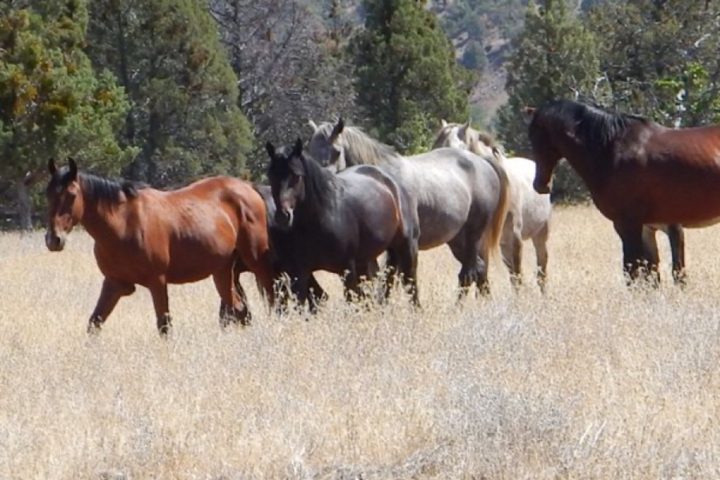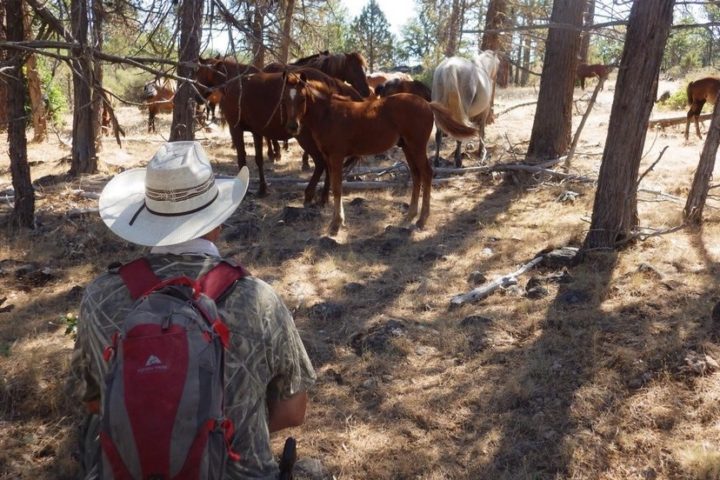By William E. Simpson II
Over the course of the past 50 years, since the passing of the 1971 Free Roaming Wild Burro And Horse Protection Act (1971 Act), the management of wild horse Herd Management Areas (HMAs) have undergone many changes resulting from both political and economic pressures, which stem from increased consumer/market demands for more (cheap) livestock products.
The Challenge
Consumerism is a significant factor influencing the use and management of our natural resources. It’s unreasonable and illogical to expect ranchers to reduce production of affordable livestock products when consumers are clamoring for more, not less. So until we see a huge spike in vegetarianism in America (and elsewhere), the demands for livestock will continue to rise as they have over the past many decades.

The Situation At Hand
The result is that today, 50 years since the passage of the 1971 Act, we find that wild horses have been limited-down to about 7% of the grazing on lands that the 1971 Act had set aside for native species American wild horses. And over the same 50-year period, those same lands have been managed by the BLM, whether right or wrong, arguably to maximize livestock production. As such, management included a significant reduction of apex predators in order to help maximize production via lower livestock losses due to depredation.
The reduction of apex predators in HMAs where livestock and wild horses are commingled presents a serious ecological issue and evolutionary injustice for the wild horses being managed in those HMAs. A depleted (or missing) population of the evolved natural predators for wild horses prevents ‘natural selection’ and population control from occurring. The evolved predators of American wild horses include; bears, wolves, mountain lions and coyotes.
Inhibiting or eliminating the evolutionary process of ‘natural selection’ creates two serious problems for America’s wild horses. Without their evolved predators living in proper population densities in ecosystems containing wild horses (including HMAs), wild horses will to some extent, depending on available water and forage resources, overpopulate. And without Natural Selection, the genetic vigor of wild horses suffers because weak, diseased and genetically defective horses are not culled from the herd by predators.
Critically important is the fact that man cannot duplicate this complex evolutionary process, which is unique between a predator and its prey, and has evolved over the millennia. All wild horses in world originally evolved about 55 million years ago in North America. The removal/reduction of apex predators from many HMAs has occurred over the course of nearly a century.
The notion held by a few people of suddenly changing course and reintroducing apex predators back into herd areas, which due to powerful economic pressures have evolved into livestock production areas (again, whether right or wrong) is just not going to fly in the face of the market demands for livestock products by the vast majority of American consumers.
The Bottom Line
Keeping American wild horses commingled with livestock in herd areas where apex predators have been depleted is perpetrating an ecologic injustice upon native species American wild horses. It’s simply obtuse management as are the many very costly workarounds, such as the failed attempts to address the fallout (overpopulation) from a lack of natural wild horse predators, using expensive roundups and contraception.

A Modern Science-Based Final Solution:
Relocate and re-wild native species American wild horses where they belong — into the remote wilderness, beyond conflict with livestock enterprises.
We have more than 10 million of acres of remote wilderness areas in the western states that are manifestly unfit for any livestock production due to difficult mountainous terrain, which adversely affects livestock management logistics, combined with the presence of robust populations of apex predators. Either one, or both of these challenges significantly increases costs of livestock production, thereby increasing the cost of goods sold (COGS) to a point where the end products are not competitively priced.
These same remote areas are nevertheless blessed with abundant water and forage, yet are suffering from almost annual catastrophic wildfire due to the depleted populations of large native herbivores (deer and elk) that had previously inhabited those landscapes. In the not-too-distant past, these same wilderness areas had proper population densities of deer and elk, which through their grazing, maintained ground fuels (grass and brush) to nominal levels year-round, keeping wildfires in the realm of normal wildfire (less fuel means less heat).
There have been serious declines in deer and elk populations in some western states (like, California, Oregon, Washington, etc.). And over the past decades, that has resulted in the increase of prodigious annually occurring ground fuels (grass and brush), which is now left un-grazed in these very remote wilderness areas. These ground fuels are then subjected to a warming climate, rendering these fuels viable for wildfire sooner in the season, and remaining as dry tinder longer.
Wildfire Fuels Reduction Using Wild Horses
Cattle and sheep have complex stomachs which digest virtually all the plant and grass seeds they consume, rending them unable to germinate. Wild horses, on the other hand, pass virtually all the seeds they consume out onto the ground in their droppings, providing a critically important reseeding function for native plants. This evolved symbiosis between wild horses and the flora of the North American continent is especially beneficial for wilderness lands that have been devastated by catastrophically hot wildfire. The droppings of wild horses also contain microorganisms (aka: microbiome) that help fire-damaged soils to recover.
Each wild horse deployed into these selected wilderness areas will symbiotically consume about 5.5 tons of grass and brush annually as the concurrently reseed the landscape, keeping a delicate ecological balance in place. The resulting wildfire fuels reduction via wild horses is virtually cost-free for taxpayers, and simultaneously solves the livestock-wild horse conflict on lands (HMAs) where livestock production is virtually a permanent enterprise.
An added benefit is taxpayers no longer have to foot the bill for the $100 million+ in annual costs (BLM spends more than $100 million annually on rounding-up and warehousing wild horses off-range), nor the expensive taxpayer costs related to the draconian sterilization-contraception concepts that some people are motivated to support.
You can find more information and a draft outline for a legislative bill here.
William E. Simpson II is a rancher and naturalist living in Northern California. You can learn more at his website, www.WHFB.us

